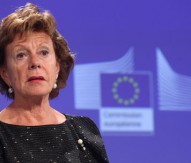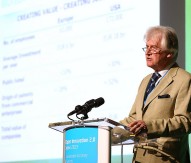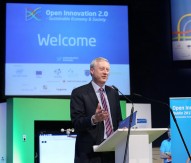
Higher education in open innovation
The ‘Open Innovation 2.0’ conference in Dublin saw the presentation of the inaugural Innovation Luminary Awards, recognising the diversity of innovation across Europe. The awards covered nine categories, notably ‘Business Model Innovation’, ‘Serial Entrepreneurship’, ‘21st Century Industrial’, ‘Creative Innovation’ and ‘Social Activism’ and winners included physicist Professor Stephen Hawking, Intel chief technology officer Justin Rattner and Austrian skydiver Felix Baumgartner.
Introducing the accolades at the conference’s gala dinner at Trinity College Dublin, which was attended by Pan European Networks, Dr Patrick Prendergast, the provost of the university, described the winners as “outstanding innovation role models” who would inspire “the next generation of innovators”.
“Over the past decade, innovation has become integral to universities, alongside our core mission in education and research. When we talk about innovation, we’re talking about growing knowledge. That knowledge is often scientific and high-tech, but it is not exclusively so. As long as you’re creating knowledge at a faster rate and to a higher level than your competitors, then you’re opening up opportunities for innovation – ultimately with the potential of creating jobs and wealth and improving society.
“Innovation cannot be confined. In Trinity, as in other universities around the world, our education is interdisciplinary. We know that today, the most innovative research happens at the interface between disciplines.”
The conference was organised in the quadruple helix innovation format, thus involving academics, industry leaders, government and citizens. According to the EU Open Innovation Strategy and Policy Group (OISPG), the body behind the conference, this new collaborative composition will help develop new entrepreneurial opportunities and bring structural changes to European innovation. Prendergast highlighted the importance of this new, dynamic form of co-operation.
“Within the innovation ecosystem, higher education institutions supply the bright, entrepreneurial graduates who are willing to take risks and forge ahead – creating new knowledge, or using that which is already there. Also crucial to the ecosystem is the business community. As we heard during the conference, innovation can be defined as the creative interaction between business, science and the citizen. We also heard that when we speak of healthy competition, then it’s not just enterprises, or indeed universities, which are in competition with each other, but whole innovation ecosystems.
“When we get used to thinking in this way about competitive ecosystems, we will stop differentiating between players and isolating the activity of, say, universities from that of enterprises. In healthy ecosystems, there is ‘cross-pollination’ and all the elements come together to work and support each other. Think of the way a good university interacts with its city or region,” Prendergast added.
The university provost cited the example of the European Institute of Innovation and Technology (EIT) as recognising the importance of developing an ecosystem following its development of three Knowledge and Innovation Communities (KICs). The EIT has developed a knowledge triangle involving higher education, the business community, and research and education to integrate these three integral parts.
“A knowledge triangle can be equated to an innovation ecosystem. Ideally, in Europe, each region will have a knowledge triangle in healthy competition with triangles from other regions, together building to a knowledge pyramid across the continent, creating growth and improving society.
“It’s exciting for universities to be so directly involved, like this, in economic growth. Our role has gone beyond educating people to get jobs – it now involves educating people to make jobs. These jobs will, of course, be created in all sectors – technological, cultural, creative, health sciences, and in all the other industries and domains that help make Europe great. That’s why the awards today take a broad view of Innovation,” the provost told delegates.
“Many of us who run universities are focused on what kind of ecosystem will emerge around us. In Dublin’s case, I think it will be a broad-based mix of high-tech, cultural, and other types of innovation. I think science, arts, and the humanities will interact, whether in performing arts, or gaming technologies and visualisation.”
Prendergast said it was important to encourage and coerce innovation aspiration and the ‘Open Innovation 2.0’ conference provided that inspiration and future opportunity.
“We know that the clustering of great innovation doesn’t just happen by magic. It needs to be strategised for, planned for, activated and incentivised. The OISPG understands the importance of incentivising and activating.
“When I was a student here in Trinity in the early 1980s, many of us were ambitious, certainly, but we weren’t ambitious to be innovators or entrepreneurs because we had little real idea of what these were. All that has changed.
“Within the university, we now have various awards recognising student, as well as staff, innovation and I know that among our undergraduates today are many who are already dreaming of, and will succeed in becoming, great innovators. Today’s event is a further inspiration.”
Dr Patrick Prendergast




